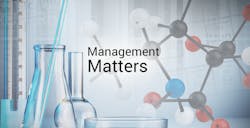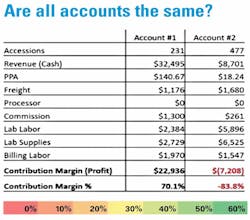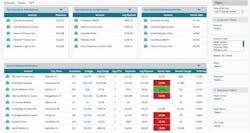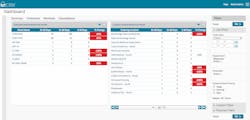How healthcare CRM can drive profitability and efficiencies in toxicology labs
The head of business development at a leading toxicology lab had an “ah-ha” moment when he compared two of the lab’s accounts. He was surprised to discover that the account with 50 percent fewer test orders was highly profitable, while the larger account actually lost money for the lab. This isn’t an unusual scenario in toxicology labs, which often move so quickly to win business from competitors that they aren’t taking the time to see if the accounts will generate profitable revenue.
According to IBISWorld, the toxicology laboratories industry is poised to grow at a rate of 3.5 percent through 2022, propelled by rapidly changing technologies and the trend among employers and law enforcement to demand toxicology tests.1 Even so, servicing unprofitable accounts isn’t a sustainable business model in any industry; in healthcare it’s particularly risky. Decreasing reimbursement rates, ongoing regulation shifts, and more discriminating healthcare consumers are putting downward pressure on profitability, making it essential to have access to the data needed to make informed decisions.
In order to gain this insight, some labs are installing healthcare-focused customer relationship management (CRM) systems to drive profitability and increase efficiencies, while delivering exceptional patient care. Often called HRM (healthcare relationship management) systems, these platforms consolidate the clinical and business data that reside in various lab systems into the platform, organize customer profiles, analyze data, and deliver business insights on dashboards for easy viewing.
With a HIPAA-compliant HRM system, all data from LIS (laboratory information systems), billing, supply, payer, and other sources is easily available to deliver a holistic view of all lab customers. HRMs then enable lab managers to measure and report on almost any metric, and set workflows based on insights that are uncovered.
Facing strong headwinds
Lab managers today are looking to HRM systems to help them thrive in an increasingly difficult operating environment.
Downward pressure on reimbursements is chief among the challenges. The new year ushered in deep cuts to reimbursement rates for some lab tests. The cuts made by the Centers for Medicare & Medicaid Services (CMS) for clinical lab tests issued under the Protecting Access to Medicare Act (PAMA) aim to save the government around $670 million annually, a 10 percent reduction from the $7 billion that it pays annually for lab tests.2
At the same time, high-deductible healthcare plans are forcing consumers to foot a higher percentage of the bill for their testing. According to TransUnion Healthcare, patients paid 11 percent more in out-of-pocket costs in 2017 than the previous year.3 This is creating more savvy and discriminating healthcare consumers who are more likely to question the necessity of healthcare tests and procedures. (That’s a good thing for everyone in the long run, but a challenge for labs nonetheless.)
HRM systems can be instrumental in helping laboratory managers identify ways to counterbalance lost revenue by making labs more profitable and efficient, while better serving providers and patients.
Better insight and decision making
One way such systems do that is by enabling laboratory sales managers to quickly identify the profitability of both current and prospective customers.
The sales team at DRUGSCAN, a Pennsylvania-based toxicology lab, typically looks at three cost components to determine profitability: insurance (network vs. out of network, Medicare, HMO vs. PPO), test mix, and premium services, such as EMR interfaces and in-office phlebotomists. Then, the team calculates the profitability of a customer account by comparing these revenue drivers with the cost to service the account, including testing labor/supplies and overhead costs. (Figure 1)
The lab also sets up an internal review and approval process for new accounts to help determine profitability on the front end, before the customer account is even live. The new account approval request is documented in the HRM system, and it includes an estimate of the payment mix by percent, which is provided from the physician’s billing manager or practice manager. This allows sales managers to forecast pipeline opportunity with estimated volume, revenue, and start date, so the lab is prepared to absorb the account.
It also allows management to identify non-profitable or marginally profitable accounts before they are activated and have important conversations with providers. For example, if a new client plans to use the lab just for HMO patients, sales reps can initiate discussions with providers to even up the payment mix by including some higher reimbursable patients. (Figure 2)
The client activation process was previously driven with emails, which often took up to three days to approve. Using the workflows built into the HRM system, new account approvals are now completed within 24 hours of the request, enabling the lab to bring in new profitable business faster.
Finally, DRUGSCAN’s lab management uses its HRM to align its sales compensation plans with company growth goals, rewarding reps for securing more profitable business.
Doing more with less
The insight generated by HRM also helps labs streamline documentation processes across departments and locations, proactively identify and address issues, and increase efficiency and productivity.
Cordant Health Solutions is a nationwide toxicology lab that includes a full-service pharmacy specializing in the complex management and dispensing of controlled substances. Lab managers adopted an HRM system to save costs by driving efficiencies. As a result, the company was able to proactively expand into several new industries while decreasing the number of sales reps by half and reducing customer support reps by 70 percent.
Before the HRM implementation, Cordant’s six labs operated independently, and each had its own IT systems, including LIS, CRM, and billing systems, which didn’t communicate between locations or departments. As a result, management had no visibility into real-time data or trends and lacked reliable information about client account health, revenue shifts, or sales activities. To get at this data, managers had to manually pull reports. Decisions were based more on anecdotes than data.
Executives knew that in order to expand their toxicology and pharmacy services, the lab needed all locations to be under the same IT umbrella to support lab services and other business segments, including medication monitoring, treatment, employee compensation, criminal justice, health plans, hospitals, and pharmacy.
Cordant’s HRM platform integrates real-time data from each separate location and provides complete operational transparency into each area of the business. Now, sales managers have detailed insight to set realistic benchmarks for reps and track forecasting timelines for new accounts. The platform also enables reps to be more proactive by analyzing ordering patterns and reaching out to clients who have not ordered supplies in the last 30 days to reduce unnecessary overnight shipping costs.
Customer support staff can quickly identify accounts with spikes in billing questions, low specimen inputs, or volume variances, allowing the team to get in front of issues before they become larger problems. (Figure 3)
The HRM also enables teams to use email messages to instantly build cases, improving time management by not having to manually type information from emails into case files.
Activity with insight
It’s been said that there is nothing so bad for business as activity without insight. In today’s challenging healthcare, environment this is certainly true. To survive and benefit from the growing demand for drug testing, toxicology labs must be lean and make decisions based on relevant data, not assumptions or “this is how we’ve always done it.” HRM systems can help pull data together from throughout the lab and deliver insights needed to make better decisions.




